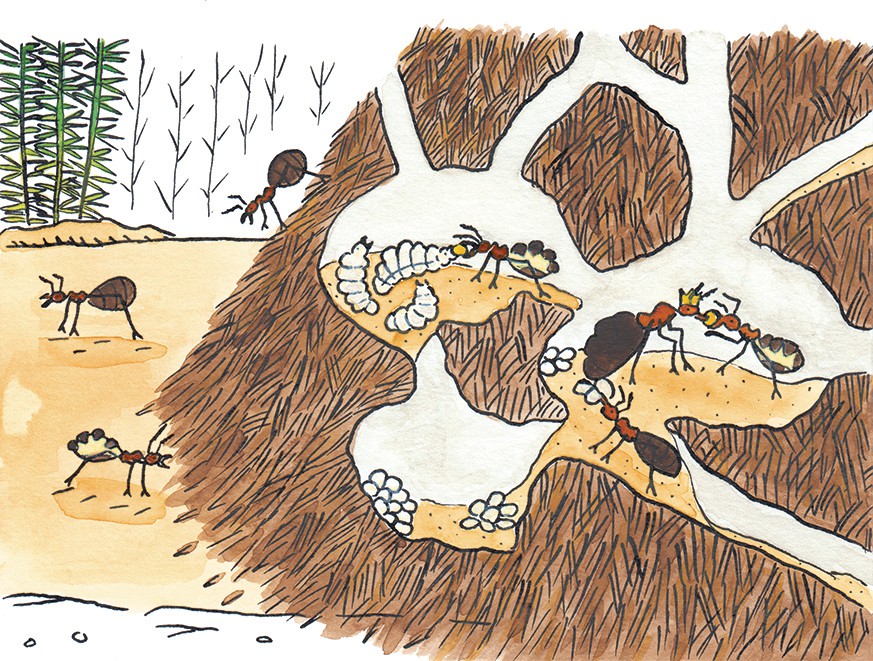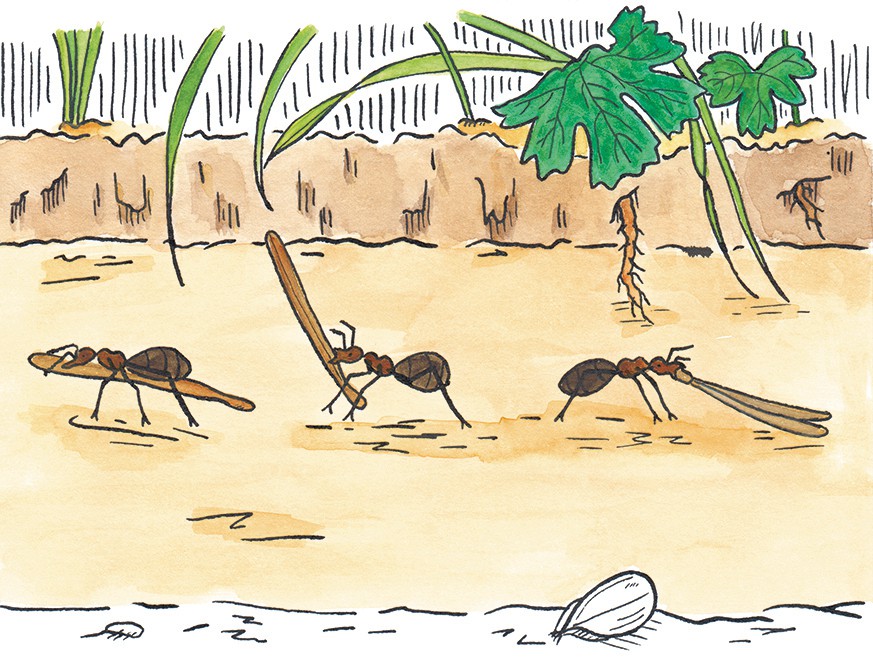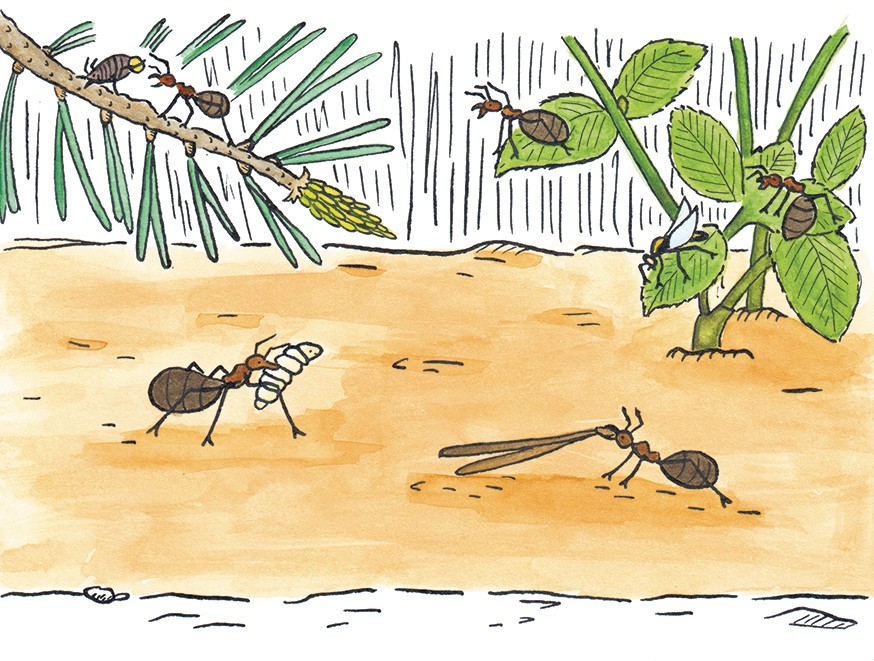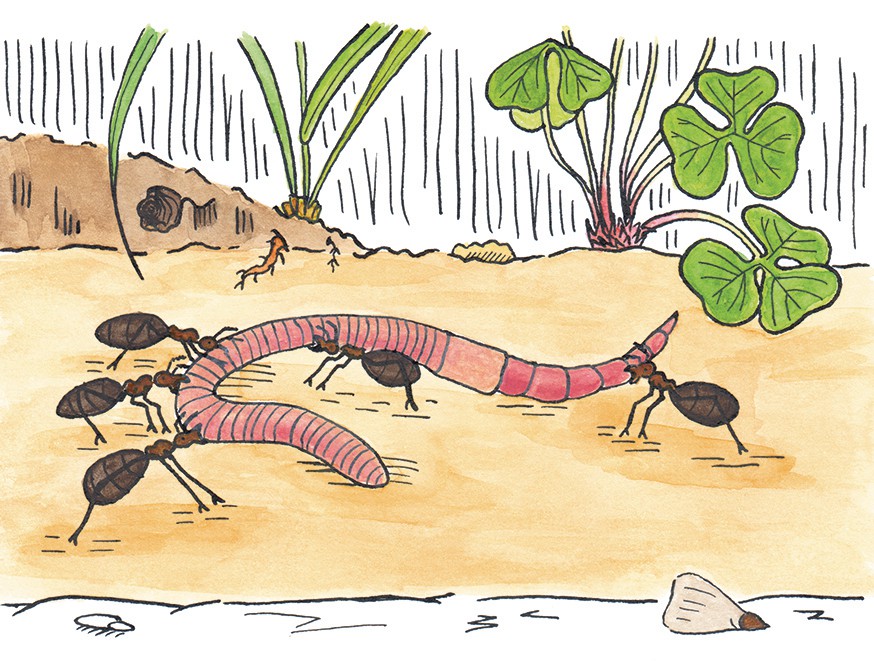It begins with a singular flight through the warm, humid spring sky – the nuptial flight. From various colonies of wood ants, winged young queens and males rise into the air. They swarm to easily recognizable landmarks, meeting over sunlit clearings, at forest edges, on grassy hills, or near solitary trees. In mid-air or while falling to the ground, they perform the act of mating with one or more partners; then their paths diverge. The males die. The fertilized young queens, however, carry out a gesture as radical as it is consequential: they tear off their own wings.
The shedding of wings seals their new role: they become queens of a state – sedentary queens. By casting off their wings, they renounce the ability to fly once and for all. They give up mobility and vastness. Instead, they begin to bind themselves to a place – and in that bond, lay the foundation for a future colony.
Some young wood ant queens found their new colony alone; others join existing nests. As soon as the location is chosen, a life begins that is inextricably tied to that patch of earth. The surrounding environment significantly influences the development of the future colony and must meet several requirements: a sunny to semi-shaded spot, nearby trees with colonies of aphids (small insects that feed on plant sap), sufficient prey insects, and access to suitable nesting materials.

Ants are masters of adaptation, but native species are dependent on a permanent home due to climatic conditions. They require the warm, humid microclimate of the nest to survive and to raise their young. Even overwintering the entire colony is only possible through the relatively warm and protected interior of the nest. Thanks to their sophisticated nesting system, native ants – unlike their close relatives, the wasps – can found multi-year colonies.
Building a nest is a gigantic, collaborative construction project: hundreds, often thousands of worker ants participate in erecting a dome made from local materials such as needles, small twigs, and soil. At its center is often a tree stump, providing additional stability. Beneath and within the dome, an extensive system of tunnels and chambers branches deep into the ground. Here, workers, offspring, and queens find shelter in a stable and carefully maintained microclimate. Separate chambers also provide space for storing food supplies.

Unsurprisingly, given the immense effort involved, the nest is built for permanence. Ants relocate only in emergencies. Large, well-situated ant mounds can persist for years or even decades. They grow slowly and are embedded in a specific environment, one that imposes certain demands on both the workers and the nest construction itself.
The queen remains deep in the center of the colony – hidden, protected, devoted solely to reproduction. Her daughters, the wingless worker ants, take on all other tasks. The young workers initially remain in the nest, keeping it clean, caring for larvae and pupae, and attending to the queen. As they grow older, they begin to leave the nest and take on new roles and responsibilities: they guard the nest and their sisters, watch for dangers, hunt prey insects, and tend to their aphid “livestock”, from which they regularly harvest honeydew to carry back to the nest as a valuable, energy-rich food source. They collect nesting material and explore new food sources.
Although they can theoretically take on any role in the colony, worker ants interestingly develop clear preferences – and even more strikingly: location preferences.

Some workers always leave the nest in the same direction, follow familiar trails, and return repeatedly to the same places and gathering spots. One example of this behavior can be seen in the aphid keepers: they return again and again to the same tree, the same branch, even the same twig to harvest honeydew from their herd of aphids. But why does a specific aphid keeper return to that exact same twig, when others would suffice just as well? Is it a fondness for specific grazing animals – or perhaps a quiet attachment to that very spot, tied to exceptional, maybe even affectionate memories? Is it simply efficiency? A learned path, a pragmatic routine?
Or is there something more? The ant’s orientation system combines chemical signals with visual cues and spatial memory. The same path offers stability and continuity; in a complex environment, it provides safety and a sense of direction. And yet, it may be more than just a habit. In their constant return, their persistent coming back to a specific place, there seems to be a moment of familiarity.

A strong bond to place defines the wood ant’s way of life: unlike native wasps, who fly aimlessly through the air and establish new colonies and nests every year, ants are long-term settlers. They develop colonies, interact with neighboring sister states, and maintain a permanent network of trails. Over time, well-maintained, well-worn ant roads emerge, often lasting for years. The trails and structures of the wood ants dig deep into the earth; through material redistribution, the sowing of herbaceous plants, and the hunting of insects, worms, and arthropods, they actively shape their environment, creating new structures and habitats within our forests.
What begins at the individual level with a broken wing becomes, at the collective level, a life rooted in place. The ants do not choose the freedom of movement – they choose the freedom to stay. In the words of Eva von Redecker’s concept of “Bleibefeitheit” (freedom to stay), one might say: they are not unfree because they do not fly – they are free because they are allowed to remain. Here, staying is not stagnation, but relationship. It is care for one’s surroundings and the construction of a shared, stable habitat.